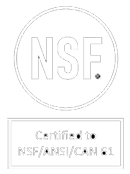Description
Continuous conductivity meter in the water line
AEGIS ll conductivity meter continuously measures and regulates conductivity and is a biocide concentration controller to keep heat exchangers and pipelines clean.
It has capacity for up to 8 sensors.
4 digital outputs 4-20 mA.
5 relés de potencia.
Recorder in micro SD memory and Wifi network connection for control through Smart technology.
Advantages of the conductivity meter
- Biocide dosing control for 1, 7 or 28 days in real time and continuously.
- Measures the concentration of biocides on-line.
- Conductivity and temperature measurement and flow control with digital sensor type CTFS.
- Standard web interface for device configuration and remote maintenance with e-mail alarm (for e-mail alarm the controller must be connected to the internet). WLAN/WIFI to choose
- Forced demineralization: performs desalination before dosing biocides according to time or measured value
- Desalination blocking: blocks desalination after dosing of biocides
Technical information.
8 digital ports for a contact hydrometer, a flow monitor and control signals.
10 operating status LEDs0.
9 flexible relay outputs, for setpoint-dependent control, flow quantity control or actuator time control.
Measured variables: Conductivity, pH, redox, chlorine, bromine, chlorine dioxide, etc.
Measuring ranges
Conductivity:
With a digital CTFS sensor at inputs A and B and via the D1 series module: 0.1 – 10 mS/cm
With the L3 conductivity module depending on the sensor used (LMP, LFT): 50 µS/cm – 20 mS/cm
With mA AA module with inductive conductivity sensor ICT: 8 to 2 mS/cm, 20 mS/cm, 200 mS/cm
Connection type mV:
pH: de 0,00 a 14,00
Redox voltage: -1 500 to +1 500 mV
Connection type mA (amperometric measurands, measuring ranges depending on the sensors, 2 ppm, 10 ppm):
Chlorine
Chlorine dioxide
Bromo
Temperature:
by means of Pt 100/Pt 1000, measuring range 0 … 150 °C
Resolution
pH: 0.01
Redox voltage: 1 mV
Temperature: 0.1 °C
Amperometry (chlorine, etc.): 0.001/0.01 ppm, 0.01 % vol., 0.1 % vol.
Inputs and outputs
3 slots for 2-channel plug-in modules in accordance with the Ident-code
1 mA input for desired analog signals
5 power relays as changeover switches, including 3 potential-free and 2 voltage-switched relays
4 pulse frequency outputs for controlling metering pumps
2 inputs for serial conductivity sensors CTFS and corrosion sensors CRS
8 control inputs for contact hydrometers, flow and pause switches for lockout
Accuracy
0.3 % referred to the end value of the measuring range
Measurement input
pH/redox (input resistance > 0.5 x 10¹² Ω)
Temperature compensation: Pt 100/Pt 1000 for pH
Temperature correction range: 0 to 100 °C
Control behavior P/PID control
Electrical connection 90 – 253 V, 50/60 Hz, 25 VA, 24 V DC
Modbus RTU field bus connection, other field buses via gateway
Ambient temperature 0 to 50 °C (for indoor installation or with protective housing)
Type of protection Wall installation: IP 67
Certificates and approvals CE, MET (corresponding to UL according to IEC 61010)
Housing material PPE with flame-retardant protection
Dimensions H x W. x D. 240 x 360 x 110 mm
Climate Permissible relative humidity: 95 % non-condensing DIN IEC 60068 – 2-30
Description of modules
AA mA/mA sensor input module (slots 1-3): 2 sensor inputs for connecting chlorine sensors such as CBR, or the pH converter pHV1
Module V2 mV/mV temperature sensor input (slots 2-3): 2 sensor inputs for connecting pH and redox sensors and Pt100/Pt1000 temperature sensors, p. e.g., of types PHER, RHER, PHEI, RHEIC, Pt100SE
H1 mA/mA output module (slots 1-3): 2 galvanically isolated 0/4-20 mA analog outputs for transmitting measured values or setting variables
Module D1 serial sensor module monitoring (slots 1-3):
Module 2 digital sensor inputs for connecting corrosion sensors CTFS or CRS
V1 mV/temperature module + mA module (slots 2-3): 1 sensor input for pH or redox sensor and temperature sensor Pt100/Pt1000, 1 sensor input for connecting chlorine sensors such as CBR, or the pH converter pHV1
CM Modbus RTU module + 2 mA outputs (slot 3): 1 Modbus RTU slave for connection to PLC or gateway, 1 Modbus RTU master for connection to Pyxis Fluorometer sensor, 2 galvanically isolated 0/4-20 mA analog outputs for transmitting measured values or setting variables
CA Modbus RTU module + 2 mA outputs + 2 mA inputs (slot 3): 1 Modbus RTU slave for connection to PLC or gateway, 1 Modbus RTU master for connection to Pyxis Fluorometer sensor, 2 galvanically isolated 0/4-20 mA analog outputs for transmitting measured values or setting variables, 2 sensor inputs for connecting chlorine sensors such as CBR, or pH converter pHV1





































